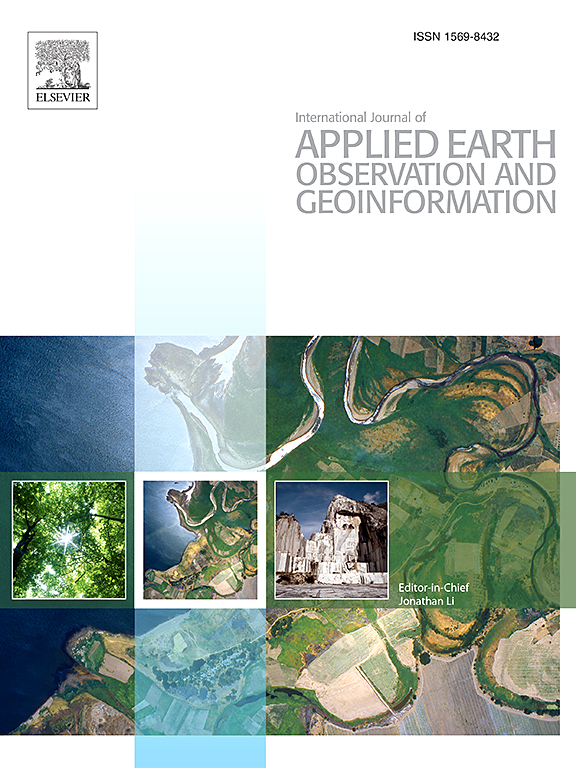哨兵卫星数据集在作物生产中土壤水分评估的应用综述
IF 7.6
Q1 REMOTE SENSING
International journal of applied earth observation and geoinformation : ITC journal
Pub Date : 2025-06-10
DOI:10.1016/j.jag.2025.104647
引用次数: 0
摘要
了解作物生产中的土壤水分动态对优化水资源管理至关重要。哨兵卫星任务通过提供高分辨率、多传感器数据,为土壤湿度监测做出了重大贡献。本文综述了利用Sentinel数据集评估土壤水分的进展,特别是在作物生产方面的进展。它强调了关键的挑战,评估了它们对监测准确性的影响,并探索了潜在的方法改进。研究结果表明,Sentinel-1的合成孔径雷达(SAR)数据,特别是VV和VH极化数据,以及Sentinel-2的多光谱指数,如NDVI和NDMI,可以广泛地与机器学习算法相结合,以增强土壤水分估算。然而,茂密的植被和复杂的地形降低了检索精度,需要传感器融合和校准来提高可靠性。Sentinel-3为间接估算土壤湿度提供了有价值的地表温度和土地状况数据,但与SAR和多光谱方法相比,由于不确定性较高,其应用仍然受到限制。新兴趋势表明,机器和深度学习技术,如RF、SVR和CNN,可以增强哨兵任务之间的数据融合。此外,预处理步骤,如RTC,散斑滤波,以及多极和极化数据与物理后向散射模型的集成,显示了减轻雷达后向散射干扰的希望。进一步开发结合地形、土壤粗糙度和质地的鲁棒检索模型对于提高不同农业景观中土壤湿度的准确性至关重要。这篇综述强调需要持续的方法进步,以最大限度地发挥Sentinel数据集在精准农业和水资源管理中土壤湿度监测的潜力。本文章由计算机程序翻译,如有差异,请以英文原文为准。
A critical review on the applications of Sentinel satellite datasets for soil moisture assessment in crop production
Understanding soil moisture dynamics in crop production is critical for optimising water resource management. The Sentinel satellite missions have significantly contributed to soil moisture monitoring by providing high-resolution, multi-sensor data. This review examines advancements in soil moisture assessment using Sentinel datasets, particularly in crop production. It highlights key challenges, evaluates their impact on monitoring accuracy, and explores potential methodological improvements. Findings indicate that Sentinel-1′s synthetic aperture radar (SAR) data, particularly VV and VH polarizations, and Sentinel-2′s multispectral indices, such as NDVI and NDMI, are widely integrated with machine learning algorithms to enhance soil moisture estimation. However, dense vegetation and complex topography reduce retrieval accuracy, necessitating sensor fusion and calibration for improved reliability. Sentinel-3 provides valuable surface temperature and land condition data for indirect soil moisture estimation, but its application remains limited due to higher uncertainty compared to SAR and multispectral approaches. Emerging trends suggest that machine and deep learning techniques, such as RF, SVR, and CNN, can enhance data fusion across Sentinel missions. Additionally, preprocessing steps such as RTC, speckle filtering, and the integration of multipolar and polarimetric data with physical backscattering models show promise in mitigating radar backscatter interference. Further development of robust retrieval models that incorporate topography, soil roughness, and texture are essential for improving soil moisture accuracy in diverse agricultural landscapes. This review underscores the need for continued methodological advancements to maximise the potential of Sentinel datasets for soil moisture monitoring in precision agriculture and water resource management.
求助全文
通过发布文献求助,成功后即可免费获取论文全文。
去求助
来源期刊

International journal of applied earth observation and geoinformation : ITC journal
Global and Planetary Change, Management, Monitoring, Policy and Law, Earth-Surface Processes, Computers in Earth Sciences
CiteScore
12.00
自引率
0.00%
发文量
0
审稿时长
77 days
期刊介绍:
The International Journal of Applied Earth Observation and Geoinformation publishes original papers that utilize earth observation data for natural resource and environmental inventory and management. These data primarily originate from remote sensing platforms, including satellites and aircraft, supplemented by surface and subsurface measurements. Addressing natural resources such as forests, agricultural land, soils, and water, as well as environmental concerns like biodiversity, land degradation, and hazards, the journal explores conceptual and data-driven approaches. It covers geoinformation themes like capturing, databasing, visualization, interpretation, data quality, and spatial uncertainty.
 求助内容:
求助内容: 应助结果提醒方式:
应助结果提醒方式:


